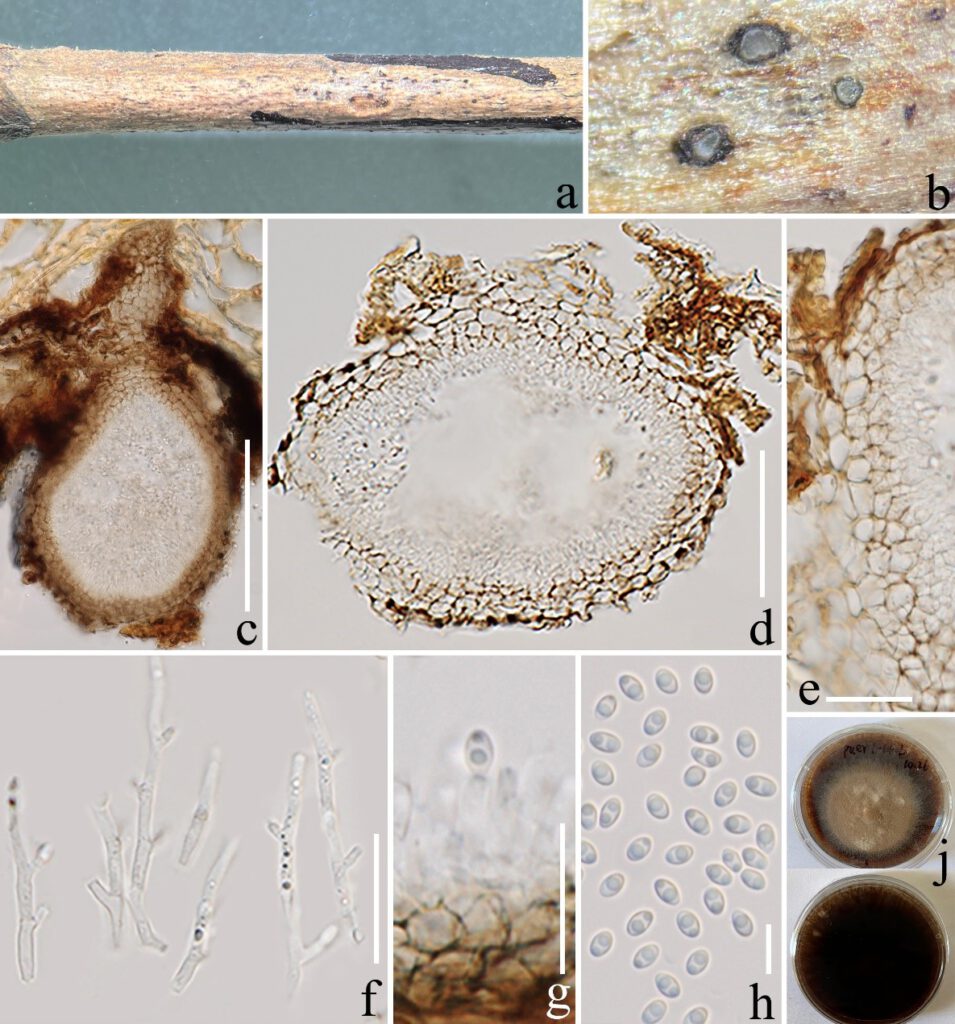Nigrograna asexualis L. Lu, K.D. Hyde & Tibpromma, sp. nov. (Figure 4)
MycoBank number: MB; Index Fungorum number: IF; Facesoffungi number: FoF 12767;
Etymology: the species epithet ‘asexualis’ refers to the asexual morph
Holotype: ZHKU 22-0123
Saprobic on decaying branch of Coffea arabica. Sexual morph: Undetermined. Asexual morph: Coelomycetous. Pycnidia 100–230 μm high, 120–180 μm wide (x̅ = 156 × 144 μm, n = 10), globose to subglobose, or pyriform, immersed, solitary, unilocular, dark brown, papillate ostiole, appearing as black spots on host surface. Peridium 11–16 μm wide (x̅ = 14 µm, n = 15), brown, the wall with pseudoparenchymatous cells. Conidiophores arising from the pycnidial wall, up to 46 μm long and 3–4.4 μm wide (x̅ = 3.4 µm, n = 25), filiform, septate, hyaline, simple to sparsely branched, with pegs along one or two sides and solitary phialides terminally. Phialides 3–6 high × 1–2 μm wide (x̅ = 4.5 × 1.5 µm, n = 15), variable in shape, phialidic, discrete, ampulliform-lageniform-subcylindrical. Conidia 5–6.5 × 3–4 μm (x̅ = 5.5 × 3.7 µm, n = 30), ellipsoidal, unicellular, aseptate with 1–2 small granules, subhyaline, smooth-walled.
Culture characteristics: Conidium germinating on PDA within 24 h. Colonies growing on PDA reaching 5 cm diam. after two months at room temperature (22–26℃). Colony dense, circular, surface sparsely hairy, radially striate, with fimbriate edge, yellowish to pale brown at the center and dark brown at the margin, reverse dark brown.
Material examined: Pu’er City, Yunnan Province, China, on decaying branch of Coffea arabica, (101°0’59”, 22°36’2” N, 1016.43 m), 16 September 2021, LiLu, Puer 1-14 (ZHKU 22-0123), ZHKUCC 22-0214 = ZHKUCC 22-0215. GenBank number; ITS: ***, LSU: ***, rpb2: ***, SSU: ***, tef1-α: *** (ZHKUCC ***); ITS: ***, LSU: ***, rpb2: ***, SSU: ***, tef1-α: *** (ZHKUCC ***).
Notes: In multigene phylogeny, Nigrograna asexualis formed a separate (68% ML, 0.97 BYPP) and distinct clade within the genus Nigrograna (Fig. 1). Morphologically, N. asexualis conforms to the morphological characteristics of the genus Nigrograna by having hyaline or sub-hyaline, long and branched conidiophores, solitary phialides, and aseptate, ellipsoidal or cylindrical conidia (Jaklitsch & Voglmayr 2016, Wanasinghe et al. 2020, Dayarathne et al. 2020). Blast results of the sequences show that ITS is similar to N. fuscidula with 89% (MH856004), and SSU is similar to N. mycophila with 99.8% (KX650510). Ellipsoidal conidia of N. asexualis are different from N. fuscidula which has oblong to cylindrical or allantoid conidia while N. mycophila has oblong to cylindrical conidia, but the similarities of these three species are conidia hyaline, 1-celled, smooth walled and forming on philipides (Jaklitsch & Voglmayr 2016). LSU and rpb2 sequences of our strain are similar to N. obliqua, and the similarities are 98.9% (KX650560) and 87% (KX650579) respectively, but N. obliqua lacks the asexual morph (Jaklitsch & Voglmayr 2016). And tef1-α sequence of our strain is 95.8% (MF939615) similar to N. locuta-pollinis, which was isolated from hive-stored pollen of Brassica campestris that lacks morphology(Zhao et al. 2018). Therefore, herein we introduce N. asexualis as a distinct new species from coffee in China.

Figure 4. Nigrograna asexualis (ZHKU 22-0123, holotype). a, b Conidiomata on the host substrate. c, d Vertical sections of a conidioma. e Peridium. f, g Conidiophores with phialides. h Conidia. j Colonies on PDA. Scale bars: c = 100 μm, d = 50 μm, e = 15 μm, f = 30 μm, g = 20 μm, h = 10 μm.
